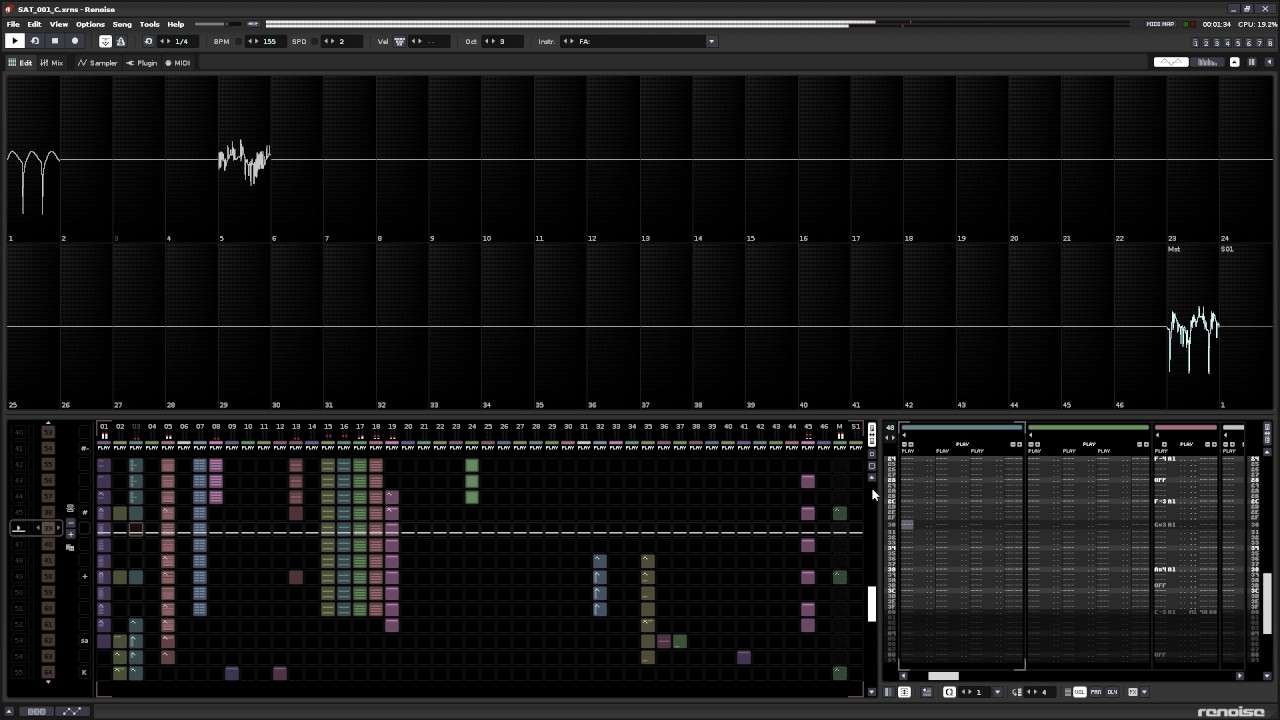Scream Tracker 3 was the first sequencing software I really sunk my teeth into. I was only like 8 years old or so, so I wasn’t doing anything particularly noteworthy then, but I remember also having a copy of some version of Cakewalk for Windows 3.1 and laboriously dragging notes out one by one and thinking “Why is this so hard? It’s easy in the tracker.” I was spoiled from the beginning.
Fast forward some time. Buzz came out, and I used that a bit - got into that plugin workflow, although I always struggled with how the pattern sequencing worked, my brain just didn’t like having everything split out instead of being there on the page. I also used Psycle which I did better with. And then I dabbled with a cracked FL Studio in college and successfully recorded some things with that, but didn’t stick with it when I next upgraded computers. By the late 2000’s, I was very much a music dabbler and read CM Magazine and everything else that the bookstores had. If I didn’t learn about Renoise there, it was probably just by searching for new trackers.
But even so, I’ve gone back and forth with using Renoise and trying other things. There have been two things that always bother me. The first is that I had some training in classical trumpet during my school years, and I just could not find a computer composing experience that let me get the sense of immediate expression I would be able to get by performing a piece with a real brass instrument, controlling both articulation and dynamics with precision. I thought perhaps having pitch and mod wheels on my keyboard would do this - not really, though. It turns out that after all this time, tracker effect columns are still the fastest way to get what I want, that kind of fine-grained manipulation.
The second thing is with music theory. My training only covered enough to suggest that I should know how to transpose things between different keys, which I did very poorly. So when I first started writing I would make chiptunes in some kind of counterpoint-esque style that I ground out by trial and error, drawing on the interlocking melodies often found in trumpet pieces, and then set simple rock beats to them. While I’ve learned a few more concepts since then, I see it as a weakness that I don’t “think” too much in terms of pitch and chord, mostly leaning on rhythm and timbre - because invariably, I will gravitate towards the comfort zone of my muscle memory and just play the same kinds of things over and over. And here, I thought, perhaps if I used an isomorphic key layout, I would be more fluid with my scales, since those layouts make it easy to transpose. This is sort of true - I’ve put money into getting not one but two isomorphic MIDI controllers(Axis49 and Chromatone), and in OpenMPT I set up keybindings for an isomorphic layout. And those do create a certain kind of fluidity, making it trivial to switch scales and modes. Isomorphics are delightful and I recommend them heartily if you want to get an intuitive grasp of theory. But they don’t really tell me how to create a chord progression, either…
…which has led me on a chase through various theory-assistance software, and even writing some of my own algorithmic music generation. Most of it is kind of dreadful in that it’s never configurable in quite the right way for what you’re doing. It generates a basic result fast, and then you’re constantly like “OK, I just want to write this adjustment but I have to try to force it through the software’s concepts”. I’ve settled into using arranger-style software(Chordpulse is my current favorite of them - very, very easy to click together something) as the cornerstone since it gives you a fairly generic starting point, but then the issue is with how to continue developing it from there.
And so I’ve been reviewing options this month and eventually thought to come back to Renoise, with an eye towards using it like a kind of “Protracker++” - the main sequence should be small and fairly sparse, easy to keep a handle on and to modify in large chunks. But that sequence can contain complex phrases and FX chains. Basically, to work at a level that is not so much note-by-note, but phrase-by-phrase.
![ANDREW SEGA [necros] Taking Tracking Mainstream](https://forum.renoise.com/uploads/default/original/2X/8/886ce4910ebb5da5cc82bbb42bc58997550ab359.jpeg)

 there were scream tracker, impulse tracker and then a bit later fast tracker 2, later modplug tracker if I remember correctly. Since then I love mods.
there were scream tracker, impulse tracker and then a bit later fast tracker 2, later modplug tracker if I remember correctly. Since then I love mods.
